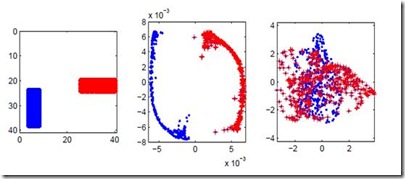This article proposes a novel methodology to learn a stable robot control law driven by dynamical systems. The methodology requires a single demonstration and can deduce a stable dynamics in arbitrary high dimensions. The method relies on the idea that there exists a latent space in which the nonlinear dynamics appears quasi linear. The original nonlinear dynamics is mapped into a stable linear DS, by leveraging on the properties of graph embeddings. We show that the eigendecomposition of the Graph Laplacian results in linear embeddings in two dimensions and quasi-linear in higher dimensions. The nonlinear terms vanish, exponentially as the number of datapoints increase, and for large density of points, the embedding appears linear. We show that this new embedding enables to model highly nonlinear dynamics in high dimension and overcomes alternative techniques in both precision of reconstruction and number of parameters required for the embedding. We demonstrate its applicability to control real robot tasked to perform complex free motion in space.
翻译:文章提出一种新的方法, 学习由动态系统驱动的稳定机器人控制法。 方法需要一个单一的演示, 并且可以推断出任意高维的稳定的动态。 方法依据的理念是, 存在一个隐性空间, 非线性动态看起来是准线性。 原始的非线性动态通过利用图形嵌入的特性绘制成稳定的线性 DS 。 我们显示, Laplacian 图的结果在两个维度的线性嵌入和更高维度的准线性嵌入中, 非线性术语随着数据点数量的增加而迅速消失, 而对于大密度的点, 嵌入似乎线性。 我们显示, 这种新的嵌入能够模拟高维度的非线性动态, 并且克服了在重建精度和嵌入所需的参数数方面的替代技术。 我们证明它适用于控制真正负责在空间上进行复杂自由运动的机器人。



